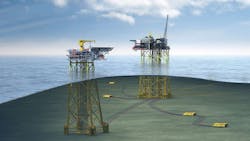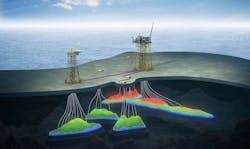Aker BP awards first North Sea NOA Fulla FEED work
Offshore staff
LYSAKER, Norway – Aker BP has issued FEED contracts worth close to NOK700 million ($81.7 million) for the multi-field NOA Fulla development in the Norwegian North Sea.
NOA Fulla is the southern part of the proposed NOAKA area project. Equinor operates the planned Krafla development to the north.
These are the first major contracts to be awarded for the development, said Aker BP svp NOAKA Lars Høier.
“Now we are getting started on further developing the concept of platforms, production systems and flowlines on the seabed. We are also developing a solution for power from shore that will pave the way for minimal greenhouse gas emissions from operations of the field.”
There will be extensive use of digital solutions to support efficiency and low emissions targets, Aker BP added.
NOAKA is located between the Oseberg and Alvheim production complexes, and contains numerous oil and gas discoveries with combined recoverable resources estimated at more than 500 MMboe, and upside through further exploration and appraisal potential.
NOA Fulla will feature a process, drilling and living quarters platform (PdQ) on NOA, a normally unmanned wellhead platform (NUI) on Frøy, and three subsea templates for development of Fulla, Langfjellet and Rind.
This will be Aker BP’s largest greenfield project to date.
Project director for NOA Fulla, Bård Atle Hovd, said: “NOA Fulla will be carried out in the alliance model, a model where we work side-by-side with strategic partners with common goals and incentives. We have a strong track record using this model, and we see clear improvements as regards efficiency and quality.”
The largest FEED contract relates to the PdQ platform, which will receive and transmit power from shore and will also process the incoming oil which will be exported via the Oseberg Transport System, while the gas will be exported via Statpipe.
Oil and produced water from Equinor’s northern (Krafla) development will also be processed on the PdQ.
“Now the Fixed Facilities Alliance between Aker Solutions, Siemens Energy, and Aker BP will spend the next year working to create a good design basis,” Hovd said.
“That, along with the other FEED deliveries, forms the basis for the plan for development and operation, which we plan to submit to the Norwegian authorities by the end of 2022.”
Aker Solutions will perform the FEED for the NOA PdQ and the normally unmanned Frøy wellhead platform (NUI), which could lead to a NOK10 billion-plus ($1.17-billion) contract award to the company, subject to a final investment decision.
The PdQ scope will likely include a topsides weighing around 22-24,000 metric tons (24,251-26,455 tons) and a jacket substructure weighing around 15,000 metric tons (16,535 tons). The Frøy NUI scope covers a topsides of around 2,000 metric tons (2,205 tons), supported by a jacket substructure of around 4,500 metric tons (4,960 tons).
The Frøy NUI, a close copy of the Hod B wellhead platform delivered by Aker Solutions in July, will be the third wellhead platform project for the Fixed Facilities Alliance since it was established in spring of 2017.
Aker Solutions’ offices in Fornebu, Norway, will manage the platforms FEED, supported by the company’s office in Mumbai, India. Work should be completed by the end of next summer.
In addition, Aker Solutions has the FEED contract for the subsea production system, as part of the Subsea Alliance with Aker BP and Subsea 7.
This will feature 14 standardized vertical subsea trees, Vectus 6.0 based control system modules, four six-slot manifolds, wellheads, and a large number of tie-in and connection systems, with FEED work led by Aker Solutions’ office in Tranby, Norway.
In addition, Aker Solutions will deliver project management for the power from shore component, including the sub-contractors for civil and electro.
Subsea 7’s FEED study for NOA Fulla covers close to 60 km (37 mi) of umbilicals, along with the flowlines and risers, with project management and engineering to be handled from the company’s office in Stavanger, Norway. Offshore installation activities should follow in 2025, 2026, and 2027.
Finally, Siemens Energy, as part of the Fixed Facilities Alliance, will manage the electrical, instrument, control systems and telecom program.
09/15/2021

